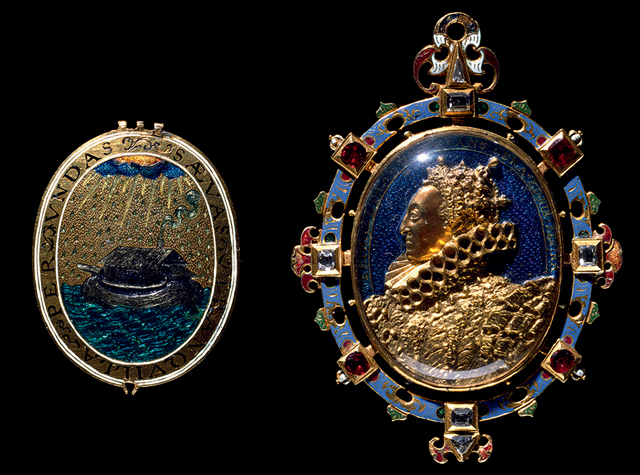Celebrating the treasures of an individual county makes for a varied and fascinating show. It should also revive interest in an exceptional town, says John Goodall.
Lincoln is presently enjoying a gala year. To coincide with the 800th anniversary of Magna Carta, the celebrated cathedral copy of this document has not only been rehoused in the restored castle, but an ambitious programme of events including concerts and exhibitions has been organised to accompany it.
One cornerstone of this programme is the so-called ‘Lincolnshire’s Great Exhibition’, which celebrates the cultural riches of the county as a whole. This is divided between four neighbouring venues (if you include the Magna Carta display): the castle, the Wren Library in the cathedral cloister, the museum called The Collection and the Usher Galley.
Each constituent display picks up themes appropriate to its setting. The Usher Gallery, for example, presents a group of paintings, drawings and sculpture in four rooms brought together from different collections, including country houses. One room is entirely dedicated to the work of the famous 18th-century artist and anatomist George Stubbs, who spent time in Lincolnshire painting horses (and more besides).
A particular highlight is the great panorama of Louth. This pair of paintings, taken from the perspective of Louth’s leviathan church spire by William Brown in 1844–56, vividly portrays the life of the prosperous town with a wealth of delightful detail. In the museum, there’s a rich assemblage of historical objects. Some celebrate individuals with Lincolnshire connections, from Lord Burghley to Margaret Thatcher. There are numerous loans from the Spalding Gentlemen’s Society, a reminder of its extraordinary collections, and the accoutrements of George IV’s Champion, a hereditary role held by the Dymoke family of Lincolnshire (COUNTRY LIFE, July 29, 2015).

Left: A page from the Luttrell Psalter, on loan from the British Library: ‘Blessed is the man that hath not walked in the counsel of the ungodly.’ Right: Part of the Louth panorama by William Brown, taken from the top of the town’s church spire in 1844–56
One show-stealer is the Luttrell Psalter, one of the greatest examples of English —even European—manuscript production of the early 14th century, on loan from the British Library. It stands open at the double-page spread showing the doleful Sir Geoffrey Luttrell at table with guests as his servants labour to produce and serve the meal.
This important manuscript loan has a counterpart in the Cathedral Library, where the two volumes of the Lincoln Chapter Bible (about 1100) are on display. These have been reunited for the first time in more than three centuries. In a small nearby vitrine is a much more modest, yet no less remarkable survival: William the Conqueror’s writ of about 1072 confirming the movement of the cathedral at Dorchester-on-Thames, Oxfordshire, to its present site at Lincoln.
Finally, the permanent redisplay of the cathedral’s copy of Magna Carta in the castle will, for many, be an independent draw in its own right. For anyone familiar with the previous home of this document, the contrast is as refreshing as it is astonishing. A vault for the charter has been created within a walled yard of the former castle prison, its façade ingeniously conceived as a rusticated wall constructed of rusted steel. It’s a brilliant and successful conceit and a happy contrast to the predict- able and doctrinaire modernism of so many museum projects in recent years.
A short introductory film prepares visitors for the sight of the document itself and the walls of the entrance hall are printed with the entire text. Displayed in the vault until September 27 is the Charter of the Forest, 1217, and a 1225 version of Magna Carta.
The full circuit of the castle walls has been made accessible for the first time. This offers visitors spectacular views of the cathedral and the county, which is spread out beneath its walls.

The Heneage Jewel, in enamelled gold, diamonds, rubies and crystals, opens to reveal a miniature of Elizabeth I (about 1595)
All in all, the ‘Great Exhibition’ offers a remarkable richness of material with flair, but it also sets off to advantage Lincoln as a whole, as the visitor who passes between the venues of the exhibition must necessarily be reminded that it remains one of England’s greatest and most beautiful county towns.
Its extraordinary topography —the ‘high’ and ‘low’ town with the aptly named Steep Hill connecting them—is truly wonderful. So, too, is the cathedral, deservedly regarded by figures as disparate as Ruskin and Pevsner as one of the most marvellous buildings in the world. Hopefully, it’s a model of display that other cathedral cities and county towns might consider emulating.
‘Lincolnshire’s Great Exhibition’ is at four Lincoln venues: The Collection and the Usher Gallery (01522 782040; www. thecollectionmuseum.com), the Castle (01522 782040; www.lincolncastle.com) and the Wren Library (01522 561640; www.lincolncathedral.com) until September 27. Details of all opening times can be found at http://historic lincolntrust.org.uk/lincoln shires-great-exhibition





